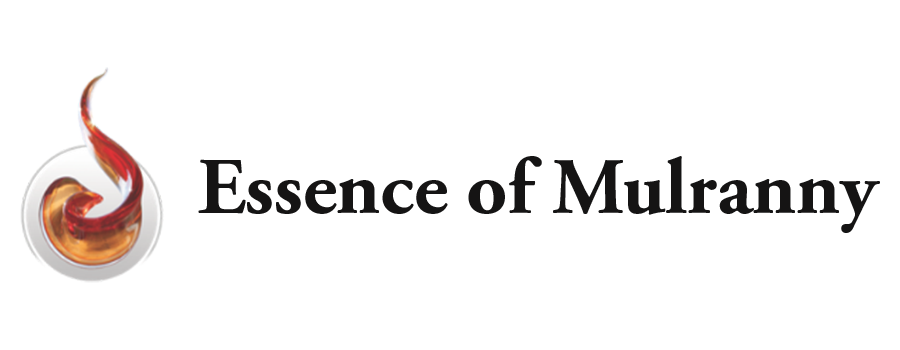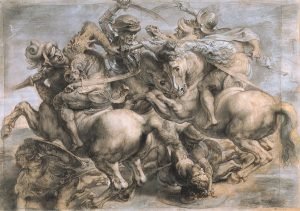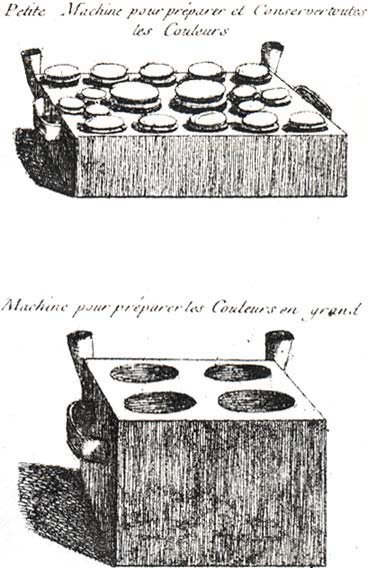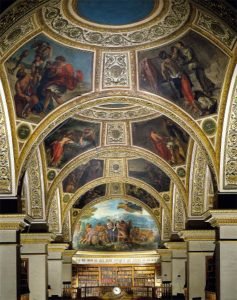Reconstruction Studies
The Renaissance revived interest in the Greco-Roman encaustic technique, framed within the period’s general spirit of recovery of technical and artistic solutions from classical antiquity. The discovery of the wall paintings at the Domus Aurea in Rome at the end of the 15th century was a shock to early Renaissance artists like Raphael, Michelangelo, Pinturicchio or Guirlandaio, who left their names on the walls as a record of their visit and showed in their work the influence caused by direct contact with Roman painting.
1504
The first known attempt to reconstruct the old technique was carried out by Leonardo da Vinci. According to the Codice Magliabechiano, Leonardo decided to paint with encaustic his most important painting commission: the wall painting of the Battle of Anghiari, in the Council Hall of the Palazzo Vecchio of Florence (1505),meant to face the Battle of Cascina commissioned to his great rival, Michelangelo. Leonardo developed a wax painting technique that seemed to work properly in smaller works. But when applied to the great wall, the technique proved uncontrollable, and Leonardo abandoned the painting unfinished.
Reconstruction works peaked during the late 18th and early 19th centuries, spurred by the discoveries at Herculaneum (1738) and Pompeii (1748) and their exceptional wall paintings. It was an age dominated by the recovery of classical culture –the age of Neoclassicism– and the scientific spirit of the Enlightenment. Between 1750 and 1800 alone, more than 60 published studies on encaustic appeared. Of the many reconstruction works carried out, we focus on two which raised great interest and controversy and proved to be especially influential. The first of these was presented by the Count of Caylus, and the second by Vicente Requeno, both leading to endless discussions and writings.
1754
Caylus presented four techniques: the application of melted waxes on waxed wood; the application of powdered waxes suspended in water, later subjected to heat treatment to set the paint; gouache on waxed wood covered by calcium carbonate powder, also with a final heat treatment to set the colours; and gouache painting covered with a sheet of wax
1787
Vicente Requeno published a reconstructive study very influential in Italy, leading to the creation of various academies devoted to encaustic painting. Requeno proposed several techniques, including: one that used heated palette-knifes to apply and spread colored waxes; another based on sodium soap and wax in water, requiring a final heating of the painting; and a third based on mastic resin, applied in molten state and completed by a final layer of melted wax, necessitating the location of a brazier near the painting.
1795
García de la Huerta proposed a cold encaustic of beeswax saponified with ash lye, mixed with resins.
Eugene Delacroix
1829
The encaustic of the painter and theorist Paillot de Montabert was a cold paint composed of wax and elemi or copal dissolved in essential oils.
1884
The reconstruction by Cros and Henry consisted of molten waxes –pure or mixed with colophony.
1885
Otto Donner von Richter proposed an encaustic of bleached beeswax saponified with soda and mixed with Chios balsam and olive oil.
1904
According to Berger, encaustic would be an emulsion of beeswax with soda or potash, mixed with oil that would be saponified by the alkali.
1910
For Laurie, encaustic paint was made with molten waxes mixed with pine balsam applied on a heated support .
1940’s
The painter Karl Zerbe developed an encaustic of beeswax mixed with sun-thickened linseed oil kept hot on an electric palette and fixed with electric heaters. Zerbe’s technique was influential among various American artists in later decades.
1949
Pratt and Fizell proposed three ancient encaustic media: wax and resin applied hot, wax dissolved in naphtha applied warm, and wax saponified with potash or soda, applied cold
Jasper Johns Flag, 1955
1960
For Hermann Kühn, ancient encaustic consisted of beeswax saponified with soda or potash.
1961
Elena Schiavi presented a reconstruction of beeswax saponified with sodium carbonate and mixed with lime and other media, to be used for wall painting. This saponified wax would be mixed with resins in order to paint on wood.
1978
According to Raymond White, encaustic painting was executed with molten waxes and also with cold waxes dissolved in naphtha or some other essential oil .
1997
Euphrosyne Doxiadis considers the Fayum portraits to have been painted with a hot encaustic composed of beeswax mixed with resin, or with a water–soluble encaustic of wax saponified by an alkali and possibly mixed with egg -and occasionally with linseed oil.
Currently, research on the composition of the ancient technique of encaustic painting is still open.






